How to use the Mezzala as a creator in FM23
Since its introduction to the Football Manager series in FM18, the Mezzala role has been hugely popular. Drenched in historic tradition, the role offers dynamism and creativity in the middle of the pitch and gives managers tremendous tactical flexibility.
However, while a Mezzala can carry out several different responsibilities within a midfield, it’s not often thought of as a team’s main creative force. In this blog, Rock’s End FM uses Manchester City’s Kevin De Bruyne to change that perception and show how you can build your attacking threats around the Mezzala.
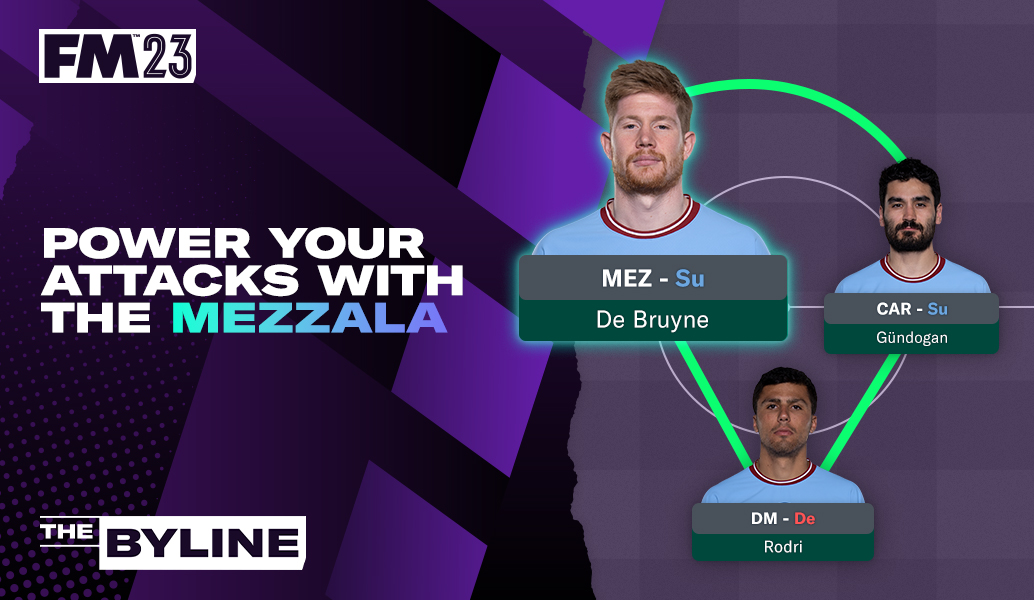
The evolution of the role
A portmanteau of the Italian words “mezza” (half) and “ala” (winger), the term Mezzala originally described players who moved in the space between central midfield and the flanks, not too dissimilar from Inside Forwards.
They were popularised in the 1960s as a key cog in the Catenaccio defensive system. There, the Mezzala was crucial as it was responsible for providing width in attack by moving into the half-space on the wing, allowing teams to stretch the opposition's defence and create space for the forwards to operate in.
In its current interpretation in FM23, the Mezzala is a dynamic midfielder who usually moves from the centre to a side of the pitch where the team has the most attacking options, allowing them to create space and provide width in the final third. In this sense, their primary task is to support the attacking players and create scoring opportunities while also providing defensive cover for the team.
It's this versatility that has made them so valuable to FM players and no player showcases this better than Manchester City’s Kevin De Bruyne. The Belgian international is a creative force in the centre of the pitch, with an exceptional ability to pick out his teammates with incisive passes and crosses. He is a master of both short and long-range passing and has a keen eye for the right moment to play the ball. At the same time, he offers incredible work rate and tireless energy, covering a lot of ground during a game, which naturally lends itself to making things happen in the final third of the pitch.
The Mezzala as the creator
How a Mezzala plays largely depends on the Attributes and Traits of the player that we select for the position, as well as the wider tactical shape and surrounding roles.
For example, you could have a dynamic runner that’ll work well in a high press and arrive late in the box for mid-range shots. Alternatively, you could employ a composed passer to offer a possession-recycling option in the final third that will play one-twos with a Winger or marauding Wing-Back.
My preferred option is using them as the playmaker of my team and here’s an example of how you can make it work.
For a Mezzala to be an effective playmaker, we need someone with excellent ball control who can make defence-splitting passes; strong First Touch, Passing, and Technique Attributes are essential. We'll also need a player with the intelligence and agility to make those plays, therefore Agility, Anticipation, Balance, Composure, Decisions, Flair and Vision are also crucial. Finally, we need someone who will be a team player, using their Off the Ball, Teamwork and Work Rate Attributes to find space and create openings.
As outlined earlier, the player that ticks those boxes better than anyone is Manchester City’s Kevin De Bruyne.
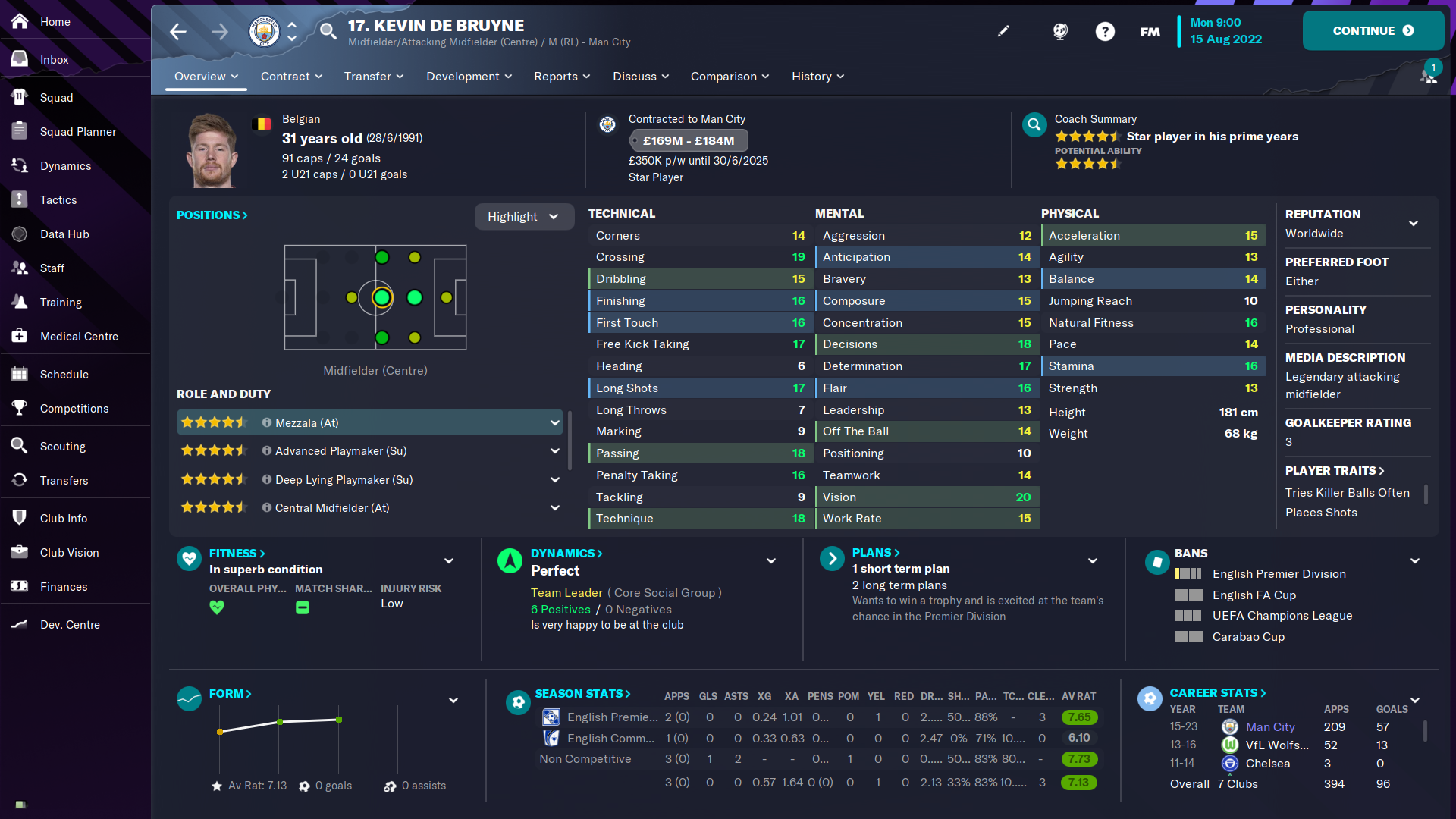
With De Bruyne in position as the team’s creative heartbeat, it’s imperative to build the team around to make the most of his skills.
First and foremost, we have to make it so that no other player is assigned that playmaking function. While a player’s natural characteristics will shine through in any role, if we mark any other players as the playmaker by using a specific role with that focus, that will take priority.
Then it’s about considering a shape that will play to his strengths. As the Mezzala will regularly roam from their position, we need someone that can provide cover in the moments of defensive transition. As such, while you can use a Mezzala in a midfield pair, it’s typically better to utilise them in a three-player setup.
Around the Mezzala you want a number of what I call ‘partners’ and ‘options’. Partners are players who will occupy nearby spaces and offer passing options under pressure or for one-twos in the build-up phase – think of a deeper-lying striker, an Inverted Winger tucking in or a Ball-Playing Defender pushing up.
Options, meanwhile, are players in charge of providing playmaking chances either with runs or exploiting wide spaces. This can be a Winger stretching the opposition wide, a striker staying on the shoulder of the last defender or a Wing-Back making a deep run.
Setting up Manchester City in this blog, we of course have De Bruyne as a Mezzala at the centre of our tactical approach. In terms of partners, I’ve picked İlkay Gündoğan as a Carillero to ensure he can always provide support and cover for the Mezzala’s movement.
I’ve also used Phil Foden as an Inverted Winger, meaning he’ll cross paths with De Bruyne often and offer a quick possession change on that flank. Sitting behind them all is Rodri, who’s meant not only as cover for the Mezzala’s marauding runs but also as a possession-recycling option.
As options, we have Bernardo Silva in his newly found role as a Wing-Back, providing deep runs and an option to stretch the opposition for De Bruyne. We also have Jack Grealish providing something similar as a Winger on Attack duty on the right, with the additional defensive cover provided behind him.
Last but not least, we have Erling Haaland. The Norwegian’s extraordinary abilities allow him to work as a partner and an option. Set as a Complete Forward on Support, he’ll be able to drop a bit deeper, dragging the defender marking him out of position and offering a shorter passing option for the Mezzala. You can also, depending on the situation, switch him to a Complete Forward on Attack to make him the spearhead of the attack.
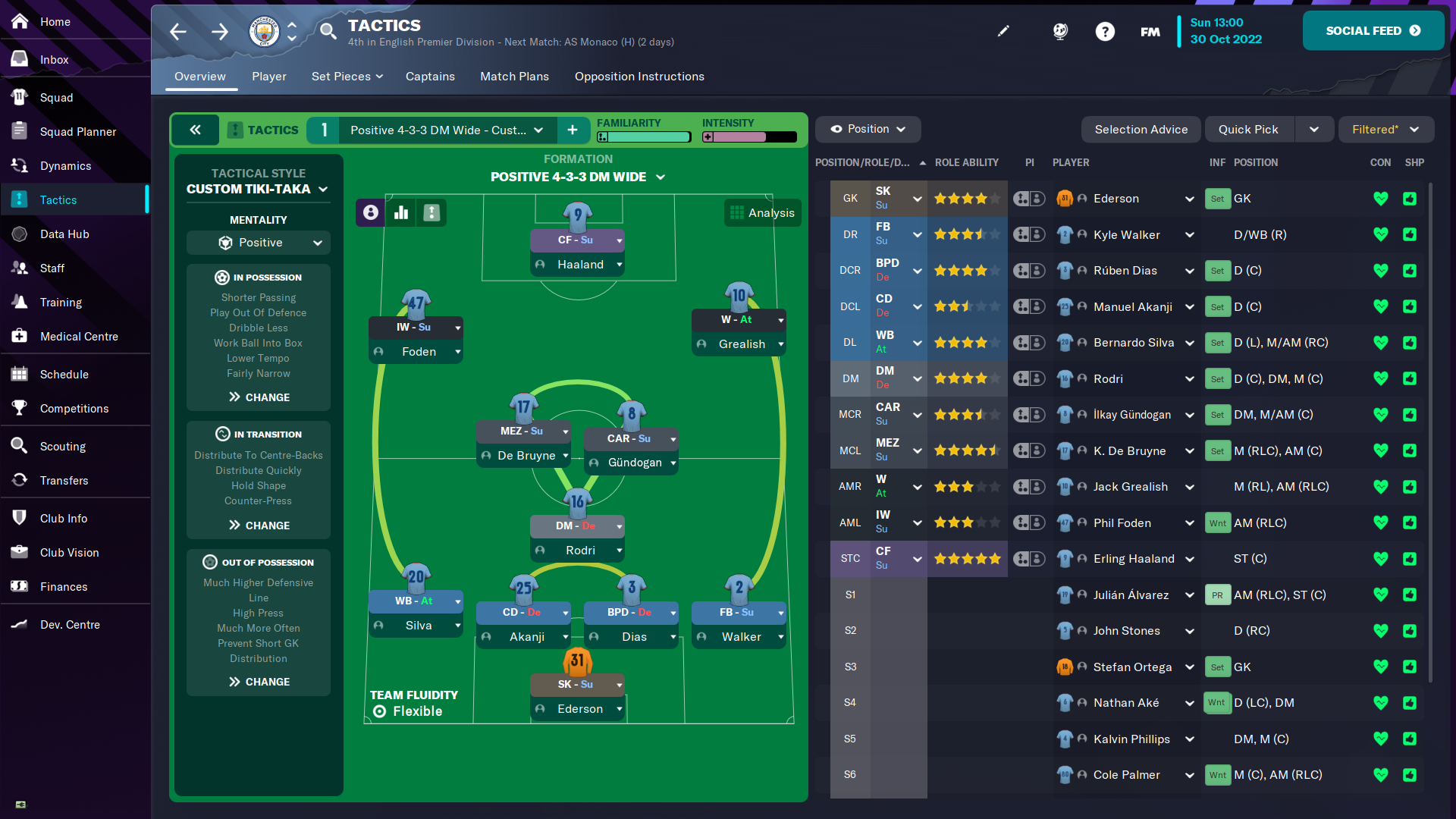
If we were to switch to a back-three formation like a 3-5-2, we’d have to look for these partners and options differently. While the idea of Silva as the marauding Wing-Back on the left remains, we’re now lacking on the right as we no longer have Jack Grealish stretching that flank. In this instance, we can switch Phil Foden to being a Deep-Lying Forward on the right and push Haaland further up. Likewise, with an extra central defender, Gündoğan and Rodri can be afforded a bit more flexibility. As you’ll see below, I’ve set Gündoğan to be a Central Midfielder on Attack and switch Rodri to a Support duty.
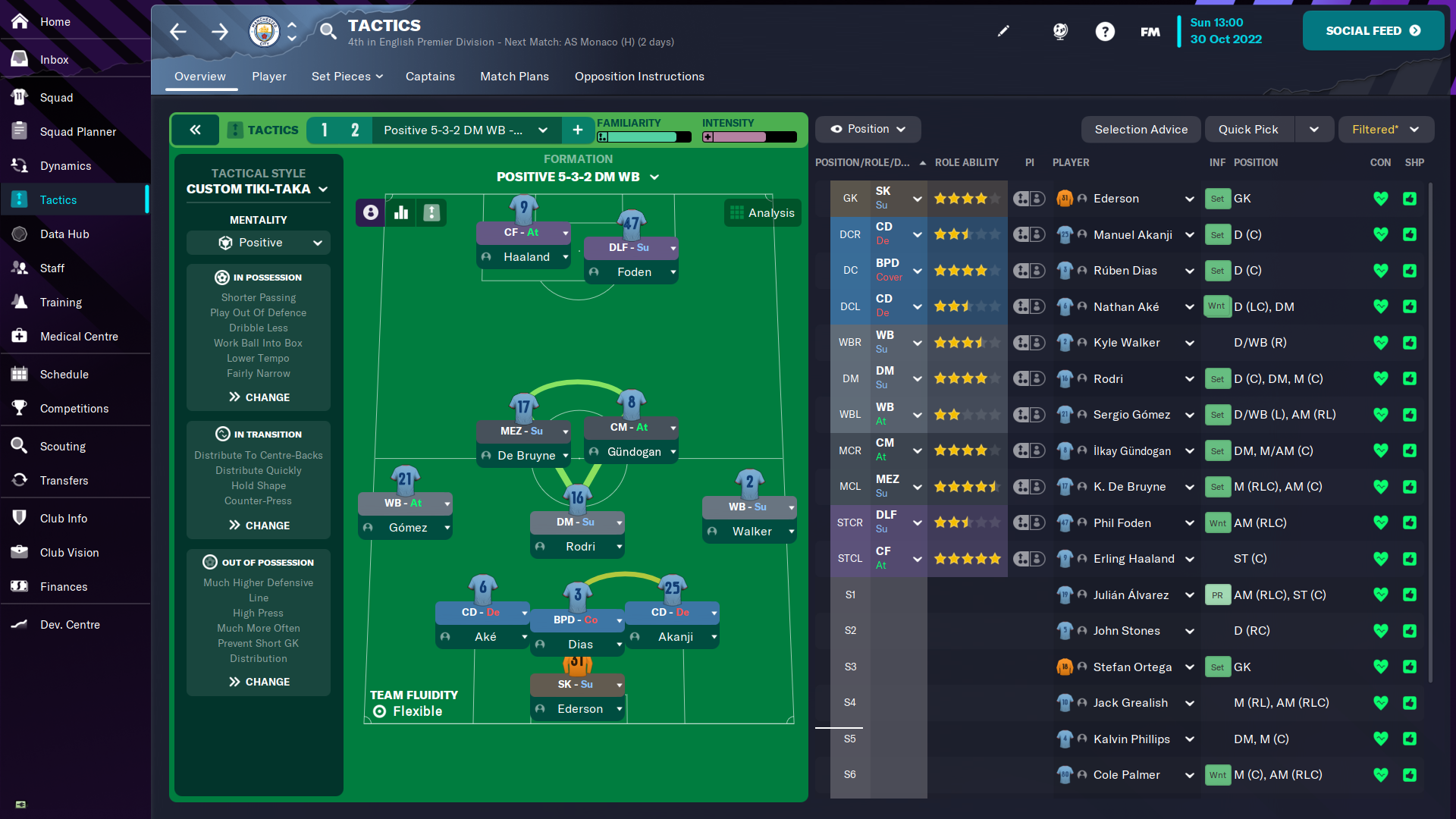
Looking into some final considerations, we must talk about the Team Instructions we’ve selected. Of course, a central part of using the Mezzala as a playmaker will be to make our team a quick-passing side that progresses the ball centrally. In this instance, you’ll see we’ve opted to make our preferred passing length shorter and ask the team to focus their play through the middle of the pitch.
If you wanted to change things up and use the Mezzala as more of a dynamic runner, you’d be best served by moving to a more direct style. Likewise, a slower, more cautious build-up approach would favour a Mezzala that could open up locked defences with their dribbling ability.
In our system with De Bruyne as the creator-in-chief, you’ll have seen that I used him on a Support duty. This is because I want him to move along at the same pace as the rest of the team and not make too many high-risk decisions. If you felt, while playing, that the Mezzala wasn’t making enough penetrative passes, you could also add the Individual Instructions that ask them for “More Direct Passing” and to “Take More Risks”.
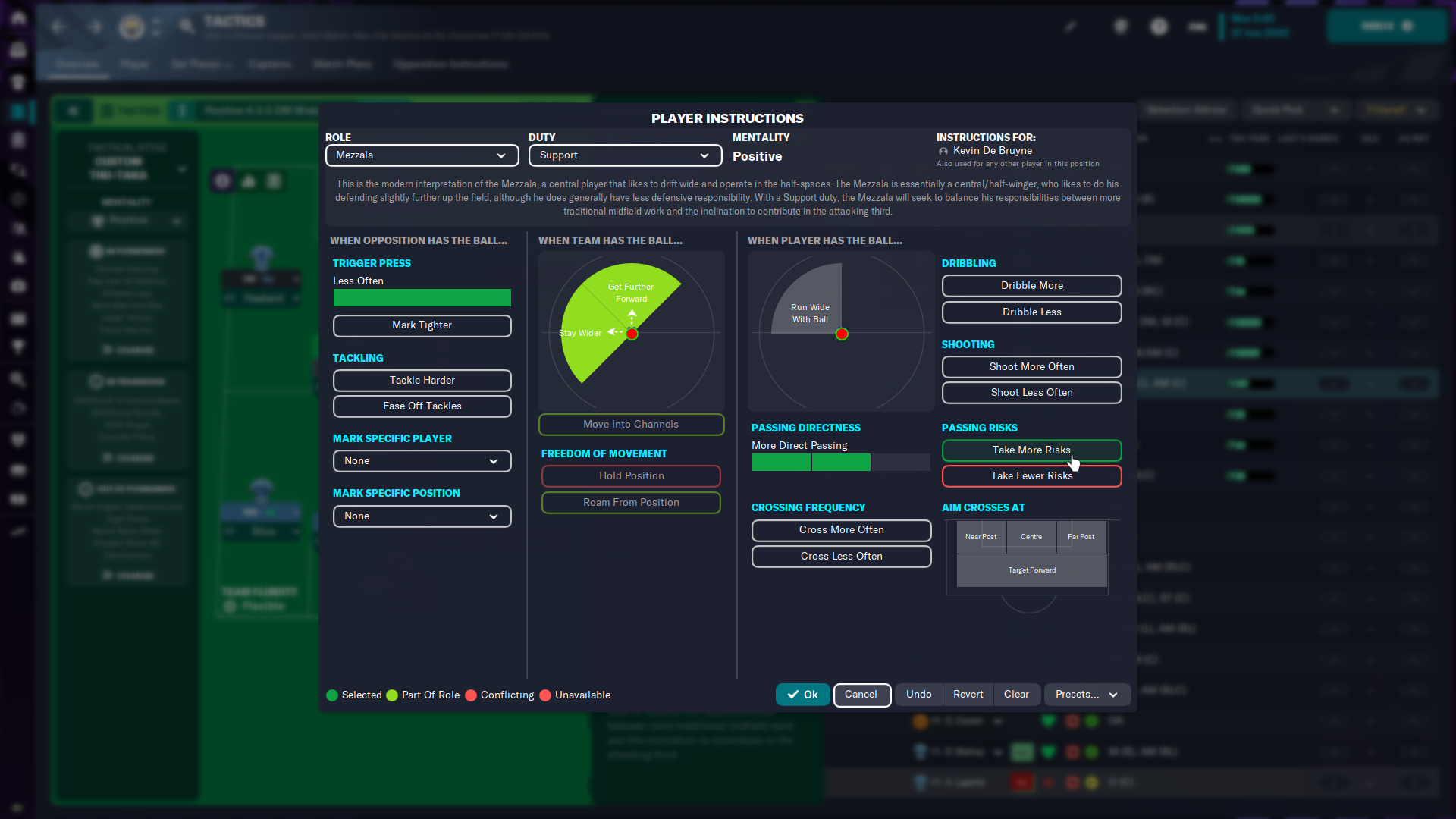
For teams where quick, sharp passing is a key strength, the Mezzala can be a tremendous playmaker, just like De Bruyne has been for Pep Guardiola for several years. I hope that with the insight I’ve provided here, you can make the most of one of FM’s most versatile roles to revamp the attacks of your team.
Happy managing,
Rock’s End FM
















